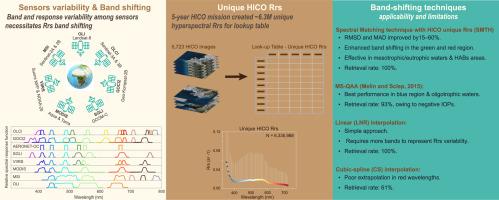Remote Sensing of Environment ( IF 13.5 ) Pub Date : 2023-10-17 , DOI: 10.1016/j.rse.2023.113846 Salem Ibrahim Salem , Hiroto Higa , Joji Ishizaka , Nima Pahlevan , Kazuo Oki

|
Comparing or integrating remote-sensing reflectance, data from multispectral sensors is hindered by differences in their nominal bands and relative spectral-response functions. Similarly, assessing satellite-to-in situ-matchup assessments of using autonomous ground radiometers, such as the Ocean Color component of the Aerosol Robotic Network (AERONET-OC), faces the same challenges. Therefore, spectral band-shifting techniques are required to approximate in spectral bands that are mutually unavailable. We present a spectral-matching technique (SMTH) using a novel look-up-table (LUT) generated from obtained from the Hyperspectral Imager for the Coastal Ocean (HICO) sensor. This LUT consists of nearly 6.3 million unique spectra, processed from 8893 Level-2 HICO scenes. An extensive in situ hyperspectral dataset (n = 8289) was used to compare the performance of SMTH with three commonly used techniques, namely Melin and Sclep (2015) “MS-QAA” model, linear (LNR) and cubic spline (CS) interpolations. The comprehensive evaluation of eight sensors using in situ dataset revealed that the SMTH has significantly better overall accuracy with respect to spectral band-shifting than the existing approaches. The Bias was improved 7-fold, whereas the root-mean-square difference (RMSD) and mean absolute difference (MAD) were ∼ 15–60% lower. Even so, each model exhibits outstanding performance in certain bands. For instance, the LNR model excels in the 380 nm band, while the MS-QAA emerges as the optimal choice for the 400 and 412 nm bands. SMTH outperforms other models in the green-red region, notably above 600 nm, where most existing ocean-color sensors have a limited number of spectral bands. Despite this variability, all models, showcase satisfactory performance in the 443–560 nm region. Significantly, both SMTH and LNR demonstrated a 100% retrieval rate, the ratio of band-shifted samples to the input samples. In contrast, MS-QAA and CS returned invalid values for 7% and 39% of the input samples, respectively. Further evaluation of regional, global, and composite satellite data suggests that the trophic state significantly influences the model performance. The MS-QAA model exhibited the smallest differences within the oligotrophic waters, characterized by low chlorophyll-a concentrations. In contrast, the SMTH model demonstrates the lowest differences in mesotrophic/eutrophic waters and regions subject to harmful algal blooms. While HICO primarily sampled coastal waters, estuaries, and shallow regions from mid- to low latitudes, there is an opportunity to enhance the representativeness of our LUT by incorporating open-ocean and high-latitude spectra from the upcoming hyperspectral missions, such as NASA's Plankton, Aerosol, Clouds, ocean Ecosystem (PACE).
中文翻译:

多光谱遥感反射产品的光谱带移动:匹配和跨任务一致性评估的见解
比较或积分遥感反射率,来自多光谱传感器的数据受到其标称波段和相对光谱响应函数的差异的阻碍。同样,评估卫星与现场的匹配评估使用自主地面辐射计,例如气溶胶机器人网络(AERONET-OC)的海洋颜色组件,也面临着同样的挑战。因此,需要光谱带移技术来近似在互不可用的光谱带中。我们提出了一种光谱匹配技术(SMTH),使用一种新颖的查找表(LUT)生成从沿海海洋 (HICO) 传感器的高光谱成像仪获得。该 LUT 由近 630 万个独特的光谱,由 8893 个 2 级 HICO 场景处理而成。使用广泛的原位高光谱数据集 ( n = 8289) 将 SMTH 的性能与三种常用技术进行比较,即Melin 和 Sclep (2015) “MS-QAA”模型、线性 (LNR) 和三次样条 (CS) 插值。使用原位数据集对八个传感器的综合评估表明,SMTH 在光谱带移方面比现有方法具有明显更好的整体精度。偏差改善了 7 倍,而均方根差 (RMSD) 和平均绝对差 (MAD) 降低了约 15-60%。即便如此,每个型号在某些频段都表现出出色的性能。例如,LNR 模型在 380 nm 波段表现出色,而 MS-QAA 则成为 400 和 412 nm 波段的最佳选择。SMTH 在绿红区域(尤其是 600 nm 以上)的性能优于其他模型,而大多数现有海洋颜色传感器的光谱带数量有限。尽管存在这种差异,所有型号均在 443-560 nm 区域表现出令人满意的性能。值得注意的是,SMTH 和 LNR 均表现出 100% 的检索率,即带移样本与输入样本的比率。相比之下,MS-QAA 和 CS 分别返回 7% 和 39% 的输入样本的无效值。对区域、全球和综合卫星数据的进一步评估表明,营养状态显着影响模型性能。MS-QAA 模型在寡营养水域中表现出最小的差异,其特点是叶绿素 a 浓度较低。相比之下,SMTH 模型显示中营养/富营养水域和受有害藻华影响的区域差异最小。虽然 HICO 主要采样了中低纬度的沿海水域、河口和浅水区域,但我们有机会通过纳入公海和高纬度地区来增强 LUT 的代表性。来自即将到来的高光谱任务的光谱,例如 NASA 的浮游生物、气溶胶、云、海洋生态系统 (PACE)。



























 京公网安备 11010802027423号
京公网安备 11010802027423号